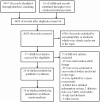Marine N-3 polyunsaturated fatty acids are inversely associated with risk of type 2 diabetes in Asians: a systematic review and meta-analysis
- PMID: 22984522
- PMCID: PMC3439396
- DOI: 10.1371/journal.pone.0044525
Marine N-3 polyunsaturated fatty acids are inversely associated with risk of type 2 diabetes in Asians: a systematic review and meta-analysis
Abstract
Background: Prospective cohort studies in relation to the associations between n-3 polyunsaturated fatty acids (PUFA) and risk of type 2 diabetes (T2D) were inconsistent. Differences in tissue n-3 PUFA compositions in subjects with and without T2D were also inconsistent in both cohort and case-control studies. We conducted a systematic review and meta-analysis of prospective cohort studies to examine the associations of fish and n-3 PUFA intake with T2D risk. The differences in tissue n-3 PUFA compositions in subjects with and without T2D were investigated based on cohort and case-control studies.
Methods and findings: PubMed, Embase, Cochrane library, China National Knowledge Infrastructure (CNKI) and Chinese VIP database up to January 2012 was used to identify relevant studies, and reference lists from retrieved studies were reviewed. Two authors independently extracted the data. Random-effects models were used to pool the summary relative risk (RR). Twenty-four studies including 24,509 T2D patients and 545,275 participants were identified. For cohort studies, the summary RR of T2D for the highest vs lowest categories of total fish, marine n-3 PUFA and alpha-linolenic acid intake was 1.07 (95% CI: 0.91, 1.25), 1.07 (95% CI: 0.95, 1.20) and 0.93 (95% CI: 0.81, 1.07), respectively. Subgroup analyses indicated that summary RR (highest vs lowest category) of T2D for fish and marine n-3 PUFA intake was 0.89 (95% CI: 0.81, 0.98) and 0.87 (95% CI: 0.79, 0.96) for Asian populations, and 1.20 (95% CI: 1.01, 1.44) and 1.16 (95% CI: 1.04, 1.28) for Western populations. Asian subjects with T2D had significantly lower tissue compositions of C22:6n-3 (SMD: -1.43; 95% CI: -1.75, -1.12) and total n-3 PUFA (SMD: -1.41; 95% CI: -2.23, -0.59) compared with those without T2D.
Conclusion: This systematic review and meta-analysis provides evidence that marine n-3 PUFA have beneficial effects on the prevention of T2D in Asian populations.
Conflict of interest statement
Figures






Similar articles
-
Polyunsaturated fatty acids (PUFA) for attention deficit hyperactivity disorder (ADHD) in children and adolescents.Cochrane Database Syst Rev. 2012 Jul 11;2012(7):CD007986. doi: 10.1002/14651858.CD007986.pub2. Cochrane Database Syst Rev. 2012. Update in: Cochrane Database Syst Rev. 2023 Apr 14;4:CD007986. doi: 10.1002/14651858.CD007986.pub3. PMID: 22786509 Free PMC article. Updated.
-
Polyunsaturated fatty acid supplementation for drug-resistant epilepsy.Cochrane Database Syst Rev. 2016 Aug 17;2016(8):CD011014. doi: 10.1002/14651858.CD011014.pub2. Cochrane Database Syst Rev. 2016. PMID: 27536971 Free PMC article.
-
Omega-3 fatty acids for the treatment of dementia.Cochrane Database Syst Rev. 2016 Apr 11;4(4):CD009002. doi: 10.1002/14651858.CD009002.pub3. Cochrane Database Syst Rev. 2016. PMID: 27063583 Free PMC article.
-
Intake of fish and marine n-3 polyunsaturated fatty acids and risk of breast cancer: meta-analysis of data from 21 independent prospective cohort studies.BMJ. 2013 Jun 27;346:f3706. doi: 10.1136/bmj.f3706. BMJ. 2013. PMID: 23814120
-
Effects of a gluten-reduced or gluten-free diet for the primary prevention of cardiovascular disease.Cochrane Database Syst Rev. 2022 Feb 24;2(2):CD013556. doi: 10.1002/14651858.CD013556.pub2. Cochrane Database Syst Rev. 2022. PMID: 35199850 Free PMC article.
Cited by
-
The Relationship between Persistent Organic Pollutants Exposure and Type 2 Diabetes among First Nations in Ontario and Manitoba, Canada: A Difference in Difference Analysis.Int J Environ Res Public Health. 2018 Mar 17;15(3):539. doi: 10.3390/ijerph15030539. Int J Environ Res Public Health. 2018. PMID: 29562596 Free PMC article.
-
Dietary Fat and Risk for Type 2 Diabetes: a Review of Recent Research.Curr Nutr Rep. 2018 Dec;7(4):214-226. doi: 10.1007/s13668-018-0244-z. Curr Nutr Rep. 2018. PMID: 30242725 Free PMC article. Review.
-
Effects of fish oil supplementation on glucose control and lipid levels among patients with type 2 diabetes mellitus: a Meta-analysis of randomized controlled trials.Lipids Health Dis. 2020 May 8;19(1):87. doi: 10.1186/s12944-020-01214-w. Lipids Health Dis. 2020. PMID: 32384902 Free PMC article.
-
Fatty acids from diet and microbiota regulate energy metabolism.F1000Res. 2015 Sep 9;4(F1000 Faculty Rev):738. doi: 10.12688/f1000research.6078.1. eCollection 2015. F1000Res. 2015. PMID: 27006755 Free PMC article. Review.
-
Association between omega-3 fatty acids consumption and the risk of type 2 diabetes: A meta-analysis of cohort studies.J Diabetes Investig. 2017 Jul;8(4):480-488. doi: 10.1111/jdi.12614. Epub 2017 Feb 3. J Diabetes Investig. 2017. PMID: 28032469 Free PMC article.
References
-
- Shaw JE, Sicree RA, Zimmet PZ (2010) Global estimates of the prevalence of diabetes for 2010 and 2030. Diabetes Res Clin Pract 87: 4–14. - PubMed
-
- Feskens EJ, Virtanen SM, Rasanen L, Tuomilehto J, Stengard J, et al. (1995) Dietary factors determining diabetes and impaired glucose tolerance. A 20-year follow-up of the Finnish and Dutch cohorts of the Seven Countries Study. Diabetes Care 18: 1104–1112. - PubMed
-
- Meyer KA, Kushi LH, Jacobs DR Jr, Folsom AR (2001) Dietary fat and incidence of type 2 diabetes in older Iowa women. Diabetes Care 24: 1528–1535. - PubMed
-
- Storlien LH, Kraegen EW, Chisholm DJ, Ford GL, Bruce DG, et al. (1987) Fish oil prevents insulin resistance induced by high-fat feeding in rats. Science 237: 885–888. - PubMed
-
- Hodge AM, English DR, O’Dea K, Sinclair AJ, Makrides M, et al. (2007) Plasma phospholipid and dietary fatty acids as predictors of type 2 diabetes: interpreting the role of linoleic acid. Am J Clin Nutr 86: 189–197. - PubMed
Publication types
MeSH terms
Substances
LinkOut - more resources
Full Text Sources
Medical

